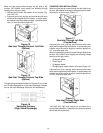
5
(c) In addition to air needed for combustion, process air
shall be provided as required for: cooling of equipment or
material, controlling dew point, heating, drying, oxidation or
dilution, safety exhaust, odor control, and air for compres-
sors.
(d) In addition to air needed for combustion, air shall be
supplied for ventilation, including all air required for comfort
and proper working conditions for personnel.
(e) While all forms of building construction cannot be
covered in detail, air for combustion, ventilation and dilution
of flue gases for gas utilization equipment vented by natural
draft normally may be obtained by application of one of the
methods covered in 5.3.3 and 5.3.4.
(f) Air requirements for the operation of exhaust fans,
kitchen ventilation systems, clothes dryers, and fireplaces
shall be considered in determining the adequacy of a space
to provide combustion air requirements.
5.3.2 Equipment Located in Unconfined Spaces: In
unconfined spaces (see definition below) in buildings,
infiltration may be adequate to provide air for combustion
ventilation and dilution of flue gases. However, in buildings
of tight construction (for example, weather stripping, heavily
insulated, caulked, vapor barrier, etc.), additional air may
need to be provided using the methods described in 5.3.3-
b or 5.3.4.
Space, Unconfined. For purposes of this Code, a space
whose volume is not less than 50 cubic feet per 1,000 BTU
per hour of the aggregate input rating of all appliances
installed in that space. Rooms communicating directly with
the space in which the appliances are installed through
openings not furnished with doors, are considered a part of
the unconfined space.
5.3.3 Equipment Located in Confined Spaces: (a)
All Air
from Inside the Building:
The confined space shall be
provided with two permanent openings communicating
directly with an additional room(s) of sufficient volume so
that the combined volume of all spaces meets the criteria
for an unconfined space. The total input of all gas utilization
equipment installed in the combined space shall be consid-
ered in making this determination. Each opening shall have
a minimum free area of 1 square inch per 1,000 BTU per
hour of the total input rating of all gas utilization equipment
in the confined space, but not less than 100 square inches.
One opening shall be within 12 inches of the top and one
within 12 inches of the bottom of the enclosure. (Figure 1 )
Figure 1
Equipment Located in Confined Spaces; All
Air from Inside Building. See 5.3.3-a
.
(b)
All Air from Outdoors:
The confined space shall be
provided with two permanent openings, one commencing
within 12 inches of the top and one commencing within 12
inches of the bottom of the enclosure. The openings shall
communicate directly, or by ducts, with the outdoors or
spaces (crawl or attic) that freely communicate with the
outdoors.
1. When directly communicating with the outdoors, each
opening shall have a minimum free area of 1 square
inch per 4,000 BTU per hour of total input rating of all
equipment in the enclosure (Figure 2).
Figure 2
Equipment Located in Confined Spaces; All
Air from Outdoors—Inlet Air from Ventilated
Crawl Space and Outlet Air to Ventilated
Attic. See 5.3.3-b
2. When communicating with the outdoors through verti-
cal ducts, each opening shall have a minimum free area
of 1 square inch per 4,000 BTU per hour of total input
rating of all equipment in the enclosure (See Figure 3).


















